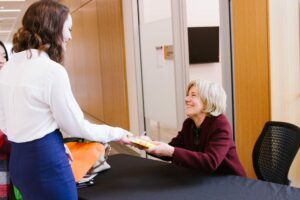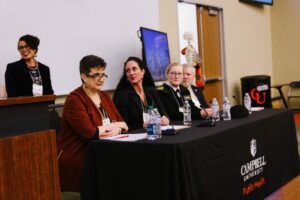The lack of oral health care in rural areas has become a crisis.
That was the underlying theme of Saturday’s Rural Oral Health Summit — a forum of oral health experts and practitioners, as well as students — hosted by Campbell’s Public Health program. The Summit’s purpose was to confront the prevalent and persistent lack of necessary dental in many rural communities, explore those problems and build strategic partnerships.
The day was another in a recent line of events positioning Campbell as a leading advocate for building better rural health care infrastructure, both locally and nationally.
 Keynote speaker Mary Otto, author of “Teeth: The Story of Beauty, Inequality, and the Struggle for Oral Health in America,” shared several stories of children and adults in rural communities becoming sick or even dying due to complications from poor oral health. Otto — who began writing about oral health as a journalist at the Washington Post, where she worked for eight years covering social issues including health care and poverty — shared the tragic story of Deamonte Driver, a young man whose tooth abscess went untreated and eventually led to bacteria reaching his brain. Davis required multiple surgeries and hundreds of thousands of dollars in medical care, before dying from what began as an easily detectable and treatable dental condition.
Keynote speaker Mary Otto, author of “Teeth: The Story of Beauty, Inequality, and the Struggle for Oral Health in America,” shared several stories of children and adults in rural communities becoming sick or even dying due to complications from poor oral health. Otto — who began writing about oral health as a journalist at the Washington Post, where she worked for eight years covering social issues including health care and poverty — shared the tragic story of Deamonte Driver, a young man whose tooth abscess went untreated and eventually led to bacteria reaching his brain. Davis required multiple surgeries and hundreds of thousands of dollars in medical care, before dying from what began as an easily detectable and treatable dental condition.
“A child had died, basically because of a toothache,” Otto said. His story, and many others, have energized oral health advocates to fight harder for better care.
Dr. Marcia Brand, a plenary speaker at the summit, identified provider shortage as the biggest barrier to good dental care in rural communities.
“If there’s no provider to see these individuals, that’s the first issue,” Brand said, referring to the statistical gap in dental care providers. Rural areas have a ratio of 65 providers per 100,000 residents; whereas the urban ratio is 105 per 100,000. This divide’s existence traces to many different factors, including the low population density of rural areas.
Most definitions classify roughly 72 percent of our nation’s landmass as rural. These locales are home to only 46 million Americans, less than 15 percent of the national population. In other words, roughly one-seventh of all Americans occupy three-quarters of our territory (2016 Census Bureau statistics).
As a result, Brand said, the span of dental care in rural locations is inadequate. The geographical dispersion coupled with 1-in-4 rural Americans living below the poverty line makes good dental care unaffordable. Good health insurance is impossible for most rural workers to access because small business and agricultural jobs rarely offer adequate coverage. Even if they have health insurance, it often does not include routine dental expenses.
Rural communities simply do not have the financial resources to support enough providers for a healthy standard of care, said Brand. Government policy is slowly beginning to attack these issues, but has no solutions yet, making private initiatives essential to the provision of good dental care for rural communities.
Brand said the Summit’s ability to attract so many public and oral health experts who otherwise would not have the multidisciplinary network for effective cooperation is important for the area.
 “[The Campbell Summit] creates a venue for cross-sector collaboration and discussion,” she said. “If the dentists are just talking to the dentists, it doesn’t address the problem. But if you have a venue like this where the policy folks, the data folks and the providers are all in the same place, we can make much more progress than we could in our individual camps.”
“[The Campbell Summit] creates a venue for cross-sector collaboration and discussion,” she said. “If the dentists are just talking to the dentists, it doesn’t address the problem. But if you have a venue like this where the policy folks, the data folks and the providers are all in the same place, we can make much more progress than we could in our individual camps.”
Summit organizers hope to extend Campbell’s problem-solving ability further into the local community and national sphere of influence.
David Tillman, chair of Campbell’s Public Health department, said is excited for the opportunity to take a leading role.
“By having this special topic summit on rural oral health, we are able to bring together universities from all across our state and experts from all around our country,” Tillman said. “We see opportunities for research and service learning as well as participating in leadership at the state level.”
Tillman’s statements meshed perfectly with President J. Bradley Creed’s invocation address, which emphasized Campbell’s commitment to leading rural communities with purpose. This view is already reflected in the Health Sciences curriculum and the university’s collaborations with other institutions of learning, government agencies and non-profit organizations.

